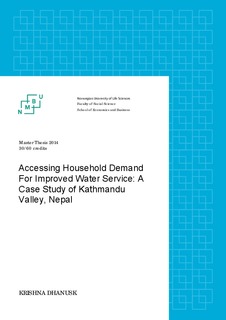| dc.description.abstract | The Contingent Valuation Method (CVM) was used to reveal the households` willingness to pay (WTP) for a water supply system improvement in Kathmandu Valley, Nepal. In-person interviews of random sample of 240 households were conducted in Kathmandu Metropolitan of Kathmandu district, Latitpur sub-metropolitan of Lalitpur district and Madyapur Thimi Municipality of Bhaktapur district of Kathmandu Valley. Cross-sectional ramdom sampling method is used to collect 80 samples from each district; 20 from each wards of respective district. Both households that are currently connected (piped) and those that are not (non-piped) were asked their WTP in terms of the monthly income, water bill, electricity bill, education etc. Melamchi Water Supply Project (MWSP) is going to complete by June, 2016. Maximum capacity of the project is 170 mld. It is supposed that MWSP will help to reduce water scarcity problem by 50% in Kathmandu Valley. So, they would pay for an improvement in the water supply services. The mean WTP of piped and non-piped households were NRs 562 (US$ 5.9) and NRs 590 (US$ 6.2) per month, respectively. Currently piped households are paying NRS 225 (US$ 2.4) per month for drinking water and sanitation. According to my research, I found that piped households are ready to pay 102% more if they will get improved water service of 10 hours per day. On the other hand, I quantified from my analysis that non-piped households are also willing to pay NRs 590 (US$ 6.2) which is little bit surprising. But ground reality is that people of Kathmandu Valley, Nepal are facing shortage of more than 200 mld per day. Its shows that non-piped households are desperately looking for option of consistent water supply service as compared to present system (i.e well water, jar water, tanker water, tube well etc). Due lack of purity and consistency in present drinking water system, non-piped households might be higher WTP than piped households.
Both piped and non-piped households are looking for consistent and purifying water service from Kathmandu Upatyaka Khanepani Limited (KUKL); main body drinking water supply in Kathmandu Valley.
Ordinary Least Square (OLS) was used to regress WTP on the explanatory variables. OLS results showed that not all of the socio-economic characteristics employed in the model have significant effects in determining the households’ WTP. Moreover, the effects of explanatory variables on WTP significantly vary between the piped and non-piped households. The analysis also revealed that the income elasticites of WTP of the piped and non-piped households were 0.147 and 0.115, respectively. These results provide important inputs to cost-benefit analyses of water supply improvement projects in Kathmandu Valley. | nb_NO |

